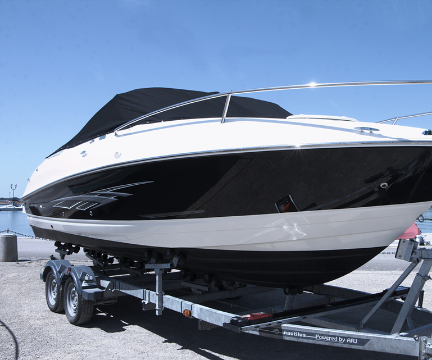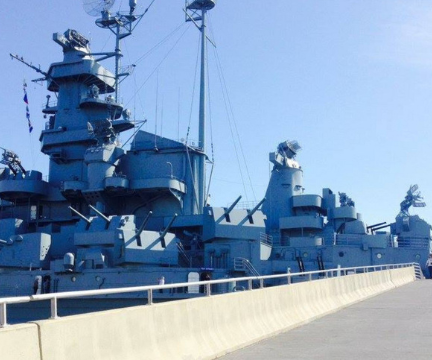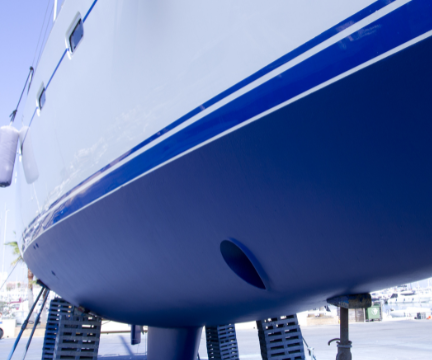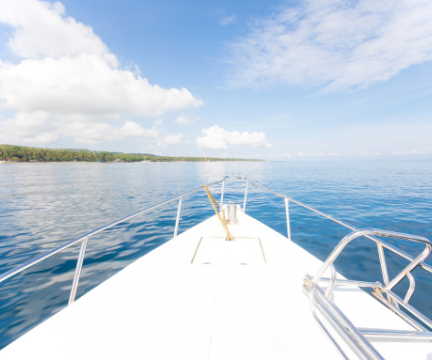
Boat Flooring
As a leading manufacturer of high-performance protective coatings, ArmorPoxy has developed comprehensive boat flooring solutions specifically engineered for marine environments. When considering epoxy for boats, ArmorPoxy's specialized formulations deliver unmatched performance and durability.
Products




Metal & Steel Industrial Coating - Aluminum Finish

Marine environments present unique challenges that standard floor coatings simply cannot handle. The combination of constant moisture, salt exposure, UV radiation, and heavy foot traffic requires specialized boat coating formulations that bond permanently to fiberglass, aluminum, and steel surfaces while maintaining superior traction and durability. Professional boat flooring systems must address these challenges through advanced chemistry that creates lasting protection.
Why Standard Coatings Fail in Marine Applications
Traditional protective coatings were never designed to withstand marine conditions. When you apply a standard garage or warehouse coating to your watercraft, you're essentially setting yourself up for failure within the first season. This is precisely why specialized epoxy for boats has become essential for serious marine operators.
The primary issue lies in the fundamental chemistry. Standard coatings lack the flexibility needed to expand and contract with temperature changes, the adhesion properties required for non-porous marine surfaces, and the chemical resistance necessary to combat salt corrosion and fuel spills.
What happens when inadequate coatings are used? First, you'll notice small areas where the coating starts to lift or bubble. Then, moisture penetrates beneath the coating, causing delamination that spreads rapidly across the entire surface. Within months, you're left with a surface that's not only unsafe but actually more difficult to clean and maintain than the original substrate.
ArmorPoxy's marine-specific formulations address these challenges while maintaining the flexibility and chemical resistance essential for marine applications. Our boat coating solutions are specifically designed to excel where traditional products fail.
Understanding Marine Surface Requirements
Professional boat flooring protection goes far beyond simply making a deck look attractive. The coating system must serve multiple critical functions simultaneously while withstanding conditions that would destroy conventional coatings within weeks. Quality epoxy for boats must provide superior traction, chemical resistance, and long-term durability.
Traction is essential in marine applications. A wet deck can become incredibly dangerous without proper texture and grip. However, the texture cannot be so aggressive that it becomes difficult to clean or causes discomfort for bare feet. ArmorPoxy's textured systems achieve the perfect balance between safety and comfort through precisely engineered aggregate distributions.
Chemical resistance becomes critical when you consider the various substances that contact marine surfaces. From engine oil and hydraulic fluid to cleaning chemicals, your deck coating must resist staining and degradation from a wide range of potentially harmful substances.
UV stability is another crucial factor often overlooked by boat owners. The combination of direct sunlight and reflection from water creates an incredibly harsh environment. Without proper UV inhibitors and colorfast pigments, coatings quickly fade, chalk, and lose their protective properties.
Flexibility and adhesion work together to ensure the coating moves through thermal cycles and structural flex without cracking or delaminating. This is particularly important for aluminum hulls and fiberglass surfaces that experience significant expansion and contraction.
ArmorPoxy's Wet Surface Epoxy: Revolutionizing Marine Applications
Traditional coating systems require completely dry surfaces, which can be virtually impossible to achieve in marine environments. ArmorPoxy's Wet Surface Epoxy represents a breakthrough in boat coating technology, allowing application directly over damp surfaces without compromising adhesion or performance. This innovation makes it one of the most versatile epoxy for boats solutions available today.
This innovative system uses moisture-activated chemistry that actually improves curing performance in humid conditions. It results in a coating that forms a permanent molecular bond even when applied in less-than-ideal conditions.
The wet surface capability doesn't mean you can ignore proper surface preparation. However, it does eliminate the frustrating delays caused by high humidity or rain. This is particularly valuable for commercial operators who cannot afford extended downtime waiting for perfect weather conditions when applying boat flooring systems.
Application versatility makes this system suitable for emergency repairs at sea. When properly prepared, the Wet Surface Epoxy can be applied underwater for emergency hull repairs, though surface applications remain the primary use case for most marine operators.
Performance characteristics include excellent abrasion resistance, superior chemical resistance, and outstanding adhesion to fiberglass, aluminum, steel, and properly prepared wood surfaces. The system maintains flexibility while providing the durability needed for heavy commercial use.
Multi Layer Steel System: Ultimate Protection for Metal Hulls
Steel and aluminum vessels face unique challenges that demand specialized protection. ArmorPoxy’s Multi Layer Steel System provides a high-performance marine coating solution designed specifically for metal hulls. The system is built on two essential components: a corrosion-inhibiting primer and a durable topcoat.
The primer forms a strong bond with the metal surface while delivering active rust and corrosion protection. Unlike simple barrier coatings, it helps prevent corrosion even if surface damage occurs.
The topcoat completes the system, providing a long-lasting shield against impact, abrasion, UV rays, and harsh marine environments. Available in different finishes, it offers both protective strength and aesthetic appeal.
Together, this two-step system delivers outstanding durability and customization for both commercial vessels and pleasure craft. When applied correctly under proper conditions, the Multi Layer Steel System can extend hull life for decades with minimal maintenance.
Heavy-Duty Textured Non-Skid Solutions
Safety on wet decks cannot be compromised, but traditional non-skid coatings often sacrifice comfort and cleanability for traction. ArmorPoxy's Heavy-Duty Textured Non-Skid system provides maximum safety without the drawbacks typically associated with aggressive textures. This specialized boat flooring solution ensures optimal traction while maintaining ease of maintenance.
Engineered aggregate distribution ensures consistent traction across the entire surface while eliminating sharp edges and uncomfortable hot spots. The aggregates are specially selected for durability, chemical resistance, and compatibility with the base coating system.
Cleanability remains excellent despite the textured surface. The non-porous finish prevents absorption of oils, blood, and other organic materials that typically stain conventional textured coatings.
Durability testing demonstrates superior performance compared to traditional non-skid materials. The integrated texture won't separate from the base coating, and the specialized aggregates maintain their profile even under heavy traffic and aggressive cleaning.
Color options allow coordination with overall vessel aesthetics while maintaining maximum functionality. Light colors help reduce surface temperatures in sunny conditions, while darker tones hide staining in commercial applications.
What Makes Marine Coatings Different from Standard Floor Coatings?
The fundamental differences between boat coating applications and standard floor coatings go far beyond simple environmental exposure. Marine environments include destructive conditions that require specialized chemistry and application techniques. Understanding these differences is crucial when selecting epoxy for boats.
Exposure to saltwater creates both immediate and long-term challenges. The high ionic concentration in seawater accelerates chemical reactions that break down conventional coating polymers. Marine-specific formulations include specialized additives that resist salt penetration and prevent the electrochemical reactions that cause rapid degradation.
Thermal cycling in marine environments is more extreme than most people realize. Dark surfaces on sunny days can reach temperatures exceeding 140°F, while overnight temperatures might drop 40-50 degrees. This constant expansion and contraction destroys rigid coatings quickly. Marine formulations maintain flexibility across extreme temperature ranges.
UV exposure intensity increases dramatically on water due to reflection and lack of shade. The combination of direct and reflected UV radiation breaks down conventional pigments and polymers rapidly. Marine coatings incorporate advanced UV inhibitors and light-stable pigments that maintain both appearance and protective properties.
Substrate adhesion becomes critical when dealing with smooth fiberglass and aluminum surfaces. These non-porous materials don't provide the mechanical adhesion available with concrete surfaces. Quality boat flooring systems use specialized chemistry that creates molecular bonds rather than relying solely on mechanical adhesion.
Flexibility requirements are more demanding because marine structures flex significantly during operation. Hull flexing, thermal expansion, and wave impact create stresses that would crack conventional coatings. Marine formulations maintain elasticity while providing protective properties.
How Long Should Marine Surface Protection Last?
Realistic expectations for boat coating longevity depend on several factors including application quality, environmental exposure, and maintenance practices. However, properly applied ArmorPoxy boat flooring systems routinely provide 10-15 years of excellent performance with minimal maintenance.
Commercial applications typically see heavier use and harsher conditions, but properly maintained systems still provide many years of service life. The key is following recommended maintenance schedules and addressing minor damage promptly before it spreads.
Environmental factors play a significant role in coating longevity. However, the difference is less dramatic with ArmorPoxy systems than with conventional coatings due to superior chemical resistance.
Usage intensity affects wear patterns but doesn't necessarily reduce overall system life when properly maintained. Heavy-use areas can be spot-repaired or recoated while the majority of the surface remains in excellent condition.
Quality of surface preparation and application technique has more impact on longevity than any other factor. A properly prepared and applied ArmorPoxy epoxy for boats system will significantly outperform premium competitors that are poorly applied. This is why choosing the right boat coating system and following proper installation procedures is so critical.
Maintenance requirements are minimal but important. Regular cleaning and periodic inspection allow early detection of any issues. Most maintenance involves simple cleaning rather than coating repairs or replacement.
Preparing Marine Surfaces for Coating Application
Proper surface preparation is absolutely critical for boat coating success, but the techniques differ significantly from standard floor preparation methods. Marine substrates present unique challenges that require specialized approaches. When preparing surfaces for epoxy for boats applications, attention to detail becomes essential.
Cleaning protocols must address marine-specific contaminants including salt deposits, fuel residues, and organic growth. Standard cleaning methods often leave invisible residues that prevent proper adhesion.
Environmental conditions during preparation significantly impact results. High humidity, temperature extremes, and salt air can interfere with surface preparation effectiveness. Proper timing and environmental control ensure optimal preparation results.
Quality control during preparation prevents costly failures. Each step must be verified before proceeding to the next phase. Simple testing methods can identify potential problems before coating application begins.
Why Traditional Paint Fails on Marine Surfaces
Understanding why conventional marine paints fail helps explain the value of advanced boat flooring systems. Traditional paint technology was never designed for the extreme conditions found in marine environments. This is why specialized boat coating solutions like ArmorPoxy's systems provide such superior performance.
UV degradation occurs quickly with standard paint pigments. Marine environments provide intense UV exposure from both direct sunlight and water reflection. Conventional paints fade, chalk, and lose protective properties within one or two seasons.
Chemical attack from fuel spills, cleaning chemicals, and salt spray breaks down conventional paint chemistry. Standard paints are formulated for architectural applications and lack the chemical resistance needed for marine use.
Thermal stress cracking occurs when rigid paint films cannot accommodate thermal expansion and contraction. Marine surfaces experience extreme temperature cycling that destroys paint film integrity rapidly.
Moisture penetration through conventional paint films allows corrosion and substrate degradation. Marine paints must provide true moisture barrier properties, not just surface coverage.
Abrasion resistance is inadequate with standard paints. Normal marine activities quickly wear through conventional paint films, exposing unprotected substrate to accelerated degradation.
Selecting the Right System for Your Application
Choosing the optimal boat coating system requires careful consideration of multiple factors including vessel type, usage patterns, environmental exposure, and performance priorities. ArmorPoxy offers epoxy for boats systems specifically designed for different marine applications, ensuring optimal performance for each unique situation.
Commercial fishing boats require maximum chemical resistance and easy cleaning capabilities. These applications typically prioritize functionality over appearance, though both can be achieved with proper system selection. The Heavy-Duty Textured Non-Skid boat flooring system often provides the best balance for these demanding applications.
Pleasure boat applications often emphasize appearance while maintaining safety and durability. The Multi-Layer Steel System Coating provides excellent appearance retention while offering superior performance compared to conventional marine paints. This makes it an ideal boat coating choice for recreational boats where aesthetics matter.
Work boat applications need maximum durability and abrasion resistance. The Wet Surface Epoxy provides superior impact resistance and longevity for boats subject to heavy use and potential damage.
Racing applications require minimum weight while maintaining safety. Specialized lightweight systems provide necessary protection without adding significant weight to the boat.
Environmental considerations include whether the vessel operates primarily in salt or fresh water, average temperature ranges, and UV exposure levels. These factors influence system selection and application specifications.
Installation Best Practices for Marine Applications
Successful marine coating installation requires attention to details that aren't critical in standard floor applications. Environmental conditions, substrate preparation, and application techniques all require modification for marine use.
Weather monitoring is essential because marine applications are more sensitive to environmental conditions than standard floor coatings. Temperature, humidity, and wind conditions all affect application success. Planning applications during optimal weather windows ensures the best results.
Surface temperature management prevents application problems and coating defects. Direct sunlight and thermal cycling can create surface temperature conditions that interfere with proper coating application. Temperature monitoring and timing adjustments prevent these issues.
Application equipment selection must consider marine environment challenges. Standard spray equipment may require modification for marine use, and brush and roller techniques need adjustment for different surface contours and accessibility challenges.
Quality control during application prevents costly failures and ensures optimal performance. Regular film thickness measurements, visual inspection, and environmental monitoring throughout the application process identify potential issues before they become serious problems.
Staging and logistics become more complex in marine applications. Limited access, tide considerations, and weather windows all affect project planning. Careful preparation and contingency planning ensure successful project completion.
Safety considerations are heightened in marine environments. Working around water, on potentially unstable surfaces, and with chemical products requires additional safety precautions and equipment.
Maintenance and Long-Term Care
Proper maintenance significantly extends the service life of marine coating systems while maintaining optimal performance and appearance. ArmorPoxy systems are designed for minimal maintenance, but regular care ensures maximum longevity.
Regular cleaning removes contaminants before they can damage the coating system. Marine environments expose coatings to salt deposits, organic growth, and various spills that can cause long-term damage if not removed promptly. Simple cleaning protocols prevent most maintenance issues.
Inspection schedules allow early detection of minor damage before it spreads. Small areas of damage can be easily repaired, but neglected damage often requires complete system replacement. Regular inspection and prompt repair minimize maintenance costs.
Cleaning methods and materials must be compatible with the coating system. Some common marine cleaning products can damage protective coatings. ArmorPoxy provides specific cleaning recommendations for each system to maintain optimal performance.
Damage repair procedures vary depending on the extent and type of damage. Minor scratches and small areas of coating loss can often be repaired with simple touch-up procedures. More extensive damage may require professional repair or partial recoating.
Environmental protection helps extend coating life. Where possible, protecting coated surfaces from unnecessary UV exposure and chemical contact reduces wear and extends service life. Simple covers and operational procedures can significantly improve coating longevity.
Recoating schedules depend on usage and environmental exposure but typically range from 10-15 years for properly maintained ArmorPoxy systems. Planning recoating projects during scheduled maintenance periods minimizes operational disruption.
Cost Analysis: Initial Investment vs. Long-Term Value
Understanding the true cost of marine surface protection requires looking beyond initial application costs to consider long-term performance, maintenance requirements, and replacement schedules. ArmorPoxy systems provide superior long-term value despite higher initial costs.
Maintenance cost savings result from the superior durability and chemical resistance of ArmorPoxy systems. Reduced cleaning time, fewer repairs, and extended service intervals significantly reduce ongoing maintenance costs.
Operational downtime costs often exceed material and labor costs for commercial boats. ArmorPoxy systems require less frequent recoating and maintenance, reducing costly downtime significantly.
Resale value considerations are particularly important for pleasure craft. Vessels with professionally applied, well-maintained ArmorPoxy systems command higher resale prices and sell more quickly than those with conventional paint systems.
Comparing ArmorPoxy to Other Marine Coating Options
Direct comparisons between ArmorPoxy systems and conventional marine coatings demonstrate clear advantages in performance, durability, and long-term value. Understanding these differences helps explain why ArmorPoxy systems are specified by demanding commercial operators.
Conventional marine paints offer lower initial cost but require frequent reapplication and maintenance. The cycle of failure and reapplication creates ongoing costs and operational disruption that quickly exceed the initial savings.
Non-skid additives in conventional systems often separate from the base coating, creating safety hazards and cleaning difficulties. ArmorPoxy's integrated texture systems maintain performance throughout the coating's service life.
Professional marine coating systems from other manufacturers often provide good performance but at significantly higher costs than ArmorPoxy systems. The performance advantage rarely justifies the price premium.
DIY marine coating kits typically fail within the first season due to inadequate surface preparation, inferior materials, or application errors. The false economy of DIY systems becomes expensive when failure requires professional remediation.
Conclusion: Investing in Superior Marine Protection
Marine surface protection is too important to compromise with inadequate solutions. The combination of safety requirements, environmental exposure, and long-term value considerations makes ArmorPoxy systems the clear choice for discriminating marine operators.
The false economy of cheaper alternatives becomes apparent quickly when considering total ownership costs, safety implications, and operational disruption from coating failures. ArmorPoxy systems provide proven performance that justifies their initial cost through extended service life and superior performance.
Whether you're protecting a commercial fishing boat, pleasure craft, or specialized marine application, ArmorPoxy has a system specifically designed for your requirements. Our technical support team can help you select the optimal system and provide guidance throughout the application process.
The investment in proper marine surface protection pays dividends in safety, durability, appearance, and operational efficiency. Don't compromise your boat's protection with inadequate solutions when proven ArmorPoxy systems provide superior performance at competitive long-term costs.




